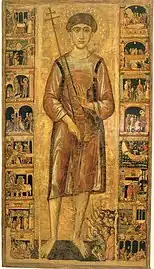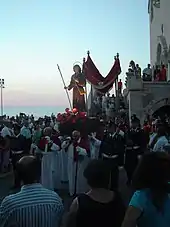Nicholas the Pilgrim
Nicholas the Pilgrim (Italian: Nicola il Pellegrino; Greek: Άγιος Νικόλαος ο Προσκυνητής; 1075 – 2 June 1094), sometimes Nicholas of Trani, is a saint of the Roman Catholic and Eastern Orthodox Church.
Nicholas the Pilgrim | |
|---|---|
 Icon of St. Nicholas the Pilgrim (Nicholas Peregrinus). | |
| Fool for Christ | |
| Born | 1075 Steiri, Boeotia, Greece. |
| Died | 2 June 1094 Trani, Apulia, Italy. |
| Venerated in | Roman Catholic Church Eastern Orthodox Church |
| Canonized | 1098, Papal State by Pope Urban II[1] |
| Major shrine | Trani Cathedral |
| Feast | June 2.[1][2][3] |
| Attributes | A beardless man wearing a brown robe and holding a cross, always bare-footed |
| Patronage | Youth, homeless youth, the mentally ill, victims of bullying, dolphins, against dumbness |

Biography
Nicholas was born at Steiri in Boeotia, Greece, where his solitary life as a shepherd led him to contemplative spirituality, as part of which he developed the constant repetition of the phrase Kyrie Eleison.[4] This brought him conflict and aggression in populated places, and he suffered much oppression.[5] His mother, believing that he was possessed by demons, sent him to live at the Hosios Loukas monastery but the monks became annoyed with his almost insane behaviour, such as the constant exclamation of the Kyrie Eleison, and expelled him.[4]
Nicholas then continued to live some life until he was nineteen when he decided to go on a pilgrimage to Rome.[4] In Naupaktos he embarked on a ship to Otranto and spent some time in the Greek-populated regions in Apulia before dying in Trani.
Veneration
Three years after Nicholas' death, archbishop Bisantius of Trani commissioned the building of a new cathedral dedicated to Nicholas and asked in 1098/99 while participating in the Lateran council Pope Urban II for his permission for the sanctification of Nicholas.[4] Trani Cathedral is dedicated to him, and he is the patron saint of the city.[6] Nicholas' life is known primarily from three sources, of which the earliest was written three years after his death based on information provided by his travel companion Bartholomew.[7]
His feast day is 2 June.[2] The annual procession through Trani in his honour is held in the last week of July.[5] In Orthodox tradition he is regarded as a Fool for Christ.[2][8]
References
- Matthew Bunson and Margaret Bunson. Our Sunday Visitor's Encyclopedia of Saints. Second Edition. Our Sunday Visitor, 2014. p. 616. ISBN 978-1612787169
- June 2. Orthodox England: Latin Saints of the Orthodox Patriarchate of Rome (St John's Orthodox Church, Colchester). Retrieved: 10 July 2017.
- The Roman Martyrology. Transl. by the Archbishop of Baltimore. Last Edition, According to the Copy Printed at Rome in 1914. Revised Edition, with the Imprimatur of His Eminence Cardinal Gibbons. Baltimore: John Murphy Company, 1916. p. 292.
- Slootjes, Daniëlle; Verhoeven, Mariette (25 March 2019). Byzantium in Dialogue with the Mediterranean History and Heritage. Brill. pp. 124–127. ISBN 9789004393585. Retrieved 4 July 2023.
- Archdiocese of Trani, Barletta, Bisceglie and Nazareth (publ.), 2004: San Nicola il Pellegrino: Atti, testimonianze e liturgie in occasione dei festeggiamenti del IX centenario della sua morte. 10 anni dopo. Trani
- Santiebeati.it: San Nicola il Pellegrino
- Kahn Herrick, Samantha (2 December 2019). Hagiography and the History of Latin Christendom, 500–1500. Brill. p. 315. ISBN 9789004417472. Retrieved 4 July 2023.
- (in Greek) "Άγιος Νικόλαος ο Προσκυνητής ο δια Χριστόν σαλός." In: ΠΕΤΡΙΔΗΣ ΙΚΑΡΟΣ. ΕΜΠΑΙΖΟΝΤΕΣ «ΗΜΕΙΣ ΜΩΡΟΙ ΔΙΑ ΧΡΙΣΤΟΝ...» ΜΟΡΦΗ ΕΚΔΟΤΙΚΗ. Μάρτιος 2008. ISBN 978-9608924178.
External links
Sources
- Cioffari, Gerardo, 1994: San Nicola Pellegrino. Levante editore
- Archdiocese of Trani, Barletta, Bisceglie and Nazareth (publ.), 2004: San Nicola il Pellegrino: Atti, testimonianze e liturgie in occasione dei festeggiamenti del IX centenario della sua morte. 10 anni dopo. Trani